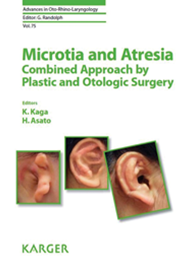In this textbook Kaga and Asato, both leading experts in otology and plastic surgery respectively, present over 10 years of their experience in joint reconstructive surgery for microtia and auricular atresia, combining autologous auricular reconstruction with external auricular canaloplasty and tympanoplasty.
The book itself is hardback and consists of 142 pages printed on premium paper. It contains 95 high-quality photographs, illustrations and figures, most of them in colour, as well as numerous graphs and tables presenting evidence-based data.
The book is divided into six main sections, each examining a different aspect of microtia and atresia. The book follows a logical and easy to follow sequence, with every section consisting of a concise abstract in the beginning, followed by one or more chapters presenting the authors’ experience and evidence base in clearly highlighted topics. Bibliographic evidence is provided at the end of each chapter.
The first main section of the textbook is a succinct but thorough review of the aetiology of microtia and atresia, presenting the evidence base of underlying genetics, both in syndromic and non-syndromic cases and examining the interactions between hereditary and environmental factors in the pathogenesis of microtia and atresia.
Section two deals with the diagnosis and preoperative assessment of microtia and atresia, as well as with the psychological changes observed in the patients before and after reconstructive surgery. It also presents the latest data in the embryological development of the auricle, external auditory canal and costal cartilage. Consistent with the book’s numerous high-quality illustrations, this section contains many excellent three-dimensional CT images of the temporal region, which provide a great preoperative guide for the optimal placement of the reconstructed auricle and external auditory canal.
Of great interest is the next main section, which focuses on surgical methods. The authors perform auricular reconstruction and canaloplasty in two stages. The first chapter in this section describes the first stage, consisting of harvesting costal cartilage and creating and inserting the auricular framework. The next two chapters present the joint second stage procedure. Elevation of the auricle and creation of a skin tube to be used for reconstruction of the external auditory canal by plastic surgeons are presented first, followed by creation of the external auditory canal and tympanoplasty by the otologists. Elevation of the auricle without canaloplasty in cases when the latter is not indicated is also described in detail in a separate chapter. Numerous images and photographs help the reader to easily follow the surgical techniques described by the authors throughout this section. Of distinct benefit to the readership is the highly detailed description of the surgical procedures used by the authors, including common pitfalls of this type of surgery and ways to avoid them.
The next two sections of the book are dedicated to the postoperative period. Section four presents the main intraoperative and postoperative complications, namely infection, skin necrosis, facial nerve palsy and chest wall deformity, while section five deals with the management and dressings of postoperative wounds, including management of the reconstructed external auditory canal. Hair removal methods are also analysed in this section.
Section six, the final section of this book, focuses on postoperative hearing. The first chapter presents the authors’ data on the effect of lateralisation of the reconstructed tympanic membrane on hearing, as well as the role of different hearing aids in these cases. Finally, CT images of the temporal bone in patients with poor hearing postoperatively are presented and analysed in the final chapter.
Overall, this textbook is a distillation of over a decade of the editors’ surgical experience in combined auricular reconstruction and canaloplasty / tympanoplasty and, as such, it is an excellent resource for plastic surgeons, otolaryngologists and audiologists interested in any of these fields. By following a logical sequence with excellent illustrations throughout, it manages to engage the reader and enhance the understanding of a highly specialised niche subject. We would highly recommend it to both beginners and experts in this field.




